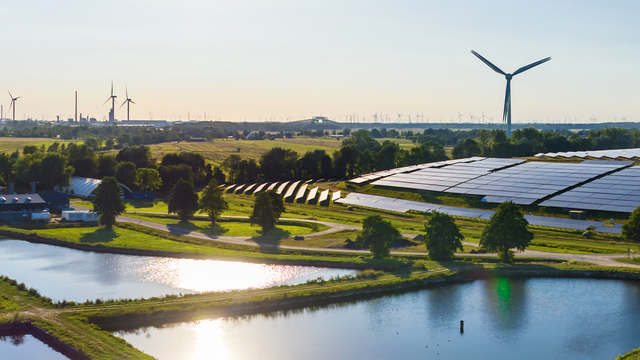Electric utilities are facing a need and opportunity to transform their business due to the bidirectional nature of distributed generation and energy storage. This is just one of several fundamental changes that the smart cities movement is driving to reshape how fundamental services are delivered and managed.
“We’re now using the grid system in a different way – it’s more diverse and more complex,” said Fred Ellermeier, Black & Veatch. “Now you’ve got bidirectional flow from renewable energy, from energy storage and from the proliferation of electric vehicles.”
Black & Veatch’s Rick Azer said a time is coming – and it’s not that far off – when distributed generation will outgrow conventional utility plant generation, in certain regions.
“Maybe five years from now, we’ll see situations where the amount of distributed generation could grow beyond the amount of conventional, centralized generation,” Azer said. “The amount of data and information needed from the systems is only going to become more and more relevant over time.”
Ellermeier said increasing connectivity will be the driver that continues to push the smart city evolution.
“Connectivity between systems will be critical in harmonizing how electric vehicles, distributed generation, energy storage and conventional generation all work together to match energy supply to demand and provide needed system resiliency,” Ellermeier noted.
Batteries Replacing Peaker Plants
One major trend Azer sees is utilities turning to large-scale stationary battery energy storage to minimize or replace the need for peaker power plants. Currently, utilities must operate peaker plants that can quickly ramp up to boost electric generation for renewables when the wind stops blowing or the sun isn’t shining.
“Battery experts are now saying that the cost of lithium ion systems has dropped to the point where it would be less expensive to build a large battery facility than it would to build a peaker plant in today’s prices,” Azer said. “And battery prices are dropping quickly as scale is increasing.”
He said utilities could find this particularly useful if battery farm sites could be located on the major transmission lines, thereby minimizing needed connecting facilities.
In a similar vein, Azer believes that energy storage will increase dramatically at commercial offices, industrial facilities and large campuses.
“Energy storage can be used at peak demand periods, thereby reducing peak demand charges from the utilities,” Azer said. “Building owners can justify the costs, because the systems can pay for themselves. Some large-scale facilities and campus environments may also have solar, microgrids or other kinds of self-generation that helps reduce demand from the grid as well.”
Black & Veatch is involved with many energy storage projects, both at the utility-scale level and at industrial facilities and campuses. “Some of these systems are as much as 20 to 50 megawatt-hours or more of capacity,” Azer said.
Increases in Time-of-Use Pricing
Evolutions due to the smart cities movement are prompting other changes to the traditional electric utility structure, Azer said.
“As production increases, there can be surpluses, so new kinds of time-of-use or real-time pricing structures will be developed,” he said. “This will foster a behavior shift. So commercial, power-hungry operations could be timed to absorb energy at moments when there’s the most energy available, meaning at the least cost to the user. Innovative rate structures that enable better timing and application of customer resources will only increase.”
He believes he is also seeing a trend toward more specialization by electric utilities.
“There is an increase in the amount of players now that are just focused on generation alone, or just transmission alone. Some of these utilities are becoming more specialized in the services they provide, and as a result, they become more reliant upon each other for elements of their service.”
Electric Utilities Preparing for New Roles in Smart City Evolution
The Evolution of Integrated Infrastructure
All of these changes are prompting the need for more integrated infrastructure that has intelligence built in, and for data analytics that can help optimize current and future operations.
“Integrated Infrastructure focuses on the convergence of physical infrastructure, communications, data and analytics,” Azer said. “Infrastructure is getting more distributed, more interconnected, and more intelligent, and this convergence of infrastructure and data analytics leads our clients to systemwide synergies.”
The goal is to increase efficiency and resiliency, and to maximize performance when dealing with distributed, interconnected systems, Azer said. The benefits lead to a higher quality of life in smart cities.
“When I look at smart cities, I see them as places that are safer, cleaner, healthier and more economically viable,” Azer said. “The utility has a pretty significant role in the manifestation of a smart city because electric power is a fundamental element of any city.”
Making the Smart Grid Even Smarter
Azer said two major components of making the electric grid work even smarter is “balance” and “awareness.” One doesn’t happen without the other.
“In order for those efficiencies to work, there has to be a lot more awareness of what is happening on the grid itself so that power demand and production can be balanced with one another. The margin of excess is minimized, so you’re not overproducing nor underproducing.”
Achieving that ideal balance also avoids the use of electricity curtailment, in which generators for renewables, such as wind farms, are turned off because they are producing too much power for the immediate needs.
“That’s where the awareness comes in – through the use of sensors and measurement controls to generate data – to help realize that balance. Those devices and the communications fabric behind them allow that data to be transported from the points of measurement back to the operations center and then to be analyzed to come up with actionable information for grid control, stability and optimization.”
Data Analytics Needed for Operational Optimization
Black & Veatch’s smart analytics platform, ASSET360TM, detects trends in near real time and allows utilities to make actionable decisions based on what is happening internally within their systems. The cloud-based platform is monitored securely while analyzing the vast amounts of data. This platform has been serving the electric utility industry for more than 20 years. It has been recently expanded to provide analytics for advanced demand response capabilities and distributed energy production/storage, as well as for smart city planning.
ASSET360 has two key components to it. Operational Intelligence provides insight into day-to-day operations and offers analysis focused on optimization, efficiencies and issue detection via real-time dashboard reporting. It includes the monitoring and diagnostics component, in which detailed operations of power generation, distribution and energy storage are monitored. This includes problem detection that allows utilities to proactively address a situation.
ASSET360 has also been applied to evaluate conservation voltage reduction, an advanced means of addressing energy efficiency opportunities. This allows for further optimization to manage a full range of energy production, distribution and utilization.
The other component is Adaptive Planning, which is the longer term predictive side of ASSET360. It focuses on examining asset life cycles and long-term capital expenditures. It uses scenario planning and big data analytics to help utilities strategize for the coming decades.
One ASSET360 solution is called SmartDG, which is a distributed generation planning tool. Using cloud computing and an economics analytical engine, SmartDG empowers utility planners to better understand how distributed generation can be deployed. When used in tandem with integrated resource plans, advance planning simulations, distribution system models and rate-making analytical tools, SmartDG equips utilities to strategize for power and grid expansion plans. It models structure rates and incentives across all customer segments.
“It is vital that utilities have a means of gaining actionable intelligence concerning their system health and stability,” Azer said. “Our tools are able to collect, analyze and interpret data coming in from multiple points along the grid to help operators maintain efficient control of their system.”
Subject Matter Experts
Fred Ellermeier: EllermeierFJ@bv.com
Rick Azer: AzerRE@bv.com








